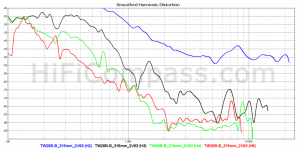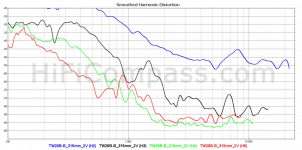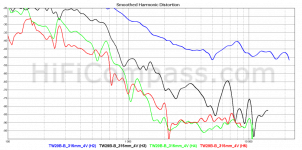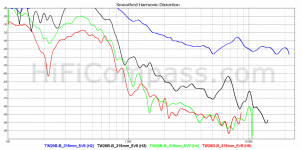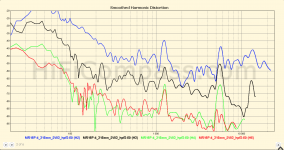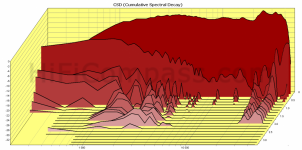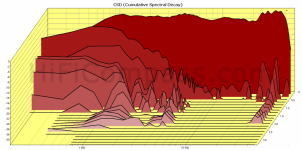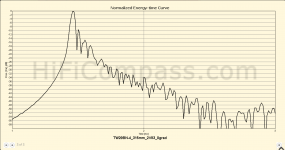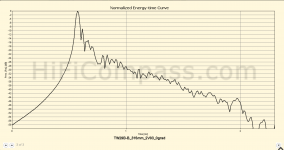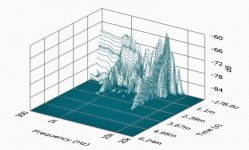That of the tweeter or the entire system?
For the tweeter itself. It's at it highest at 1,1 kHz at 1,8 % gradually going down without any peaks to under 0,2 % from 5,5 to 8 kHz and then gradually rising to 1 % at 10 kHz and then slightly lowering again to 0,8 % at 20 kHz.
This is at 94 dB.
For the entire system, this was the last in-room measurement I made at 75 dB:
Thank you, it just caught my attention because I have some very nice AMT tweeters and I wanted to know where they stand.
Thank you, it just caught my attention because I have some very nice AMT tweeters and I wanted to know where they stand.
Well this together with the Scan-Speak beryllium tweeters are probably the lowest distortion domes available on the market as bare drivers so they're a good reference. Though good AMTs can have even lower distortion. The Mundorf hifiAMT 25s for example and some of their other models have half or less the distortion of the beryllium Revelator tweeter.
I know you dream of building the best speakers ever. While that will remain a dream for a bit longer, learn to properly adjust the speakers you have right now.
An electrical slope says nothing in a crossover, no matter how fancy it's name can be. Only the acoustical slope counts when crossing over one driver to the next.
An in room (at listening spot) frequency curve should not be flat. There are good reasons for that. I know you dream about those high dollar speakers, but what you have can sound way more sweet than what you've heard so far.
Don't try to mimic those high dollar setups, go listen to real music and make that your new reference. It shouldn't sound like speakers, it should sound just like that real musical performance.
Even the BBC dip you call trickery is there on lots of speakers for a good reason. The reason being you and I have two ears we listen with, not one microphone capsule.
If you want to do it right, start with the known basics. They have been pointed out to you here, go investigate the knowledge of the people at Harmon, they are no fools.
Be arured if you want your speakers to sound right, it takes more than slapping together some electrical slopes and EQ it flat. Get the acoustical slopes right for whatever crossover you desire, but know it will be almost impossible to have a first order crossover that works without mayor draw backs.
You'd be better of with second order, and if you want you could use phase compensation (with FIR filters) in order to keep the transient response you're after.
Just my 2 cents...
An electrical slope says nothing in a crossover, no matter how fancy it's name can be. Only the acoustical slope counts when crossing over one driver to the next.
An in room (at listening spot) frequency curve should not be flat. There are good reasons for that. I know you dream about those high dollar speakers, but what you have can sound way more sweet than what you've heard so far.
Don't try to mimic those high dollar setups, go listen to real music and make that your new reference. It shouldn't sound like speakers, it should sound just like that real musical performance.
Even the BBC dip you call trickery is there on lots of speakers for a good reason. The reason being you and I have two ears we listen with, not one microphone capsule.
If you want to do it right, start with the known basics. They have been pointed out to you here, go investigate the knowledge of the people at Harmon, they are no fools.
Be arured if you want your speakers to sound right, it takes more than slapping together some electrical slopes and EQ it flat. Get the acoustical slopes right for whatever crossover you desire, but know it will be almost impossible to have a first order crossover that works without mayor draw backs.
You'd be better of with second order, and if you want you could use phase compensation (with FIR filters) in order to keep the transient response you're after.
Just my 2 cents...
Agree with comments
My own experience with crossovers parallel yours. Higher order eg third order produce unexpected results and can sound strange. Second order Butterworth, with suitable reversal of speakers seem more musical and simpler to implement than more complex configurations.
I know you dream of building the best speakers ever. While that will remain a dream for a bit longer, learn to properly adjust the speakers you have right now.
An electrical slope says nothing in a crossover, no matter how fancy it's name can be. Only the acoustical slope counts when crossing over one driver to the next.
An in room (at listening spot) frequency curve should not be flat. There are good reasons for that. I know you dream about those high dollar speakers, but what you have can sound way more sweet than what you've heard so far.
Don't try to mimic those high dollar setups, go listen to real music and make that your new reference. It shouldn't sound like speakers, it should sound just like that real musical performance.
Even the BBC dip you call trickery is there on lots of speakers for a good reason. The reason being you and I have two ears we listen with, not one microphone capsule.
If you want to do it right, start with the known basics. They have been pointed out to you here, go investigate the knowledge of the people at Harmon, they are no fools.
Be arured if you want your speakers to sound right, it takes more than slapping together some electrical slopes and EQ it flat. Get the acoustical slopes right for whatever crossover you desire, but know it will be almost impossible to have a first order crossover that works without mayor draw backs.
You'd be better of with second order, and if you want you could use phase compensation (with FIR filters) in order to keep the transient response you're after.
Just my 2 cents...
My own experience with crossovers parallel yours. Higher order eg third order produce unexpected results and can sound strange. Second order Butterworth, with suitable reversal of speakers seem more musical and simpler to implement than more complex configurations.
I have no crossovers  , see: The making of: The Two Towers (a 25 driver Full Range line array)
, see: The making of: The Two Towers (a 25 driver Full Range line array)
All I'm trying to point out is that a first order crossover will be quite difficult to achieve. One does not slap on an electic slope and be done with it.
Second order is quite doable in comparison. As long as we are truly talking about acoustical slopes it will take less effort than creating a true first order setup.
No crossover? Well, it does present other compromises that I was willing to make.
I have used second order slopes as well as mixed slopes like Harsch and preferred those to higher order slopes. I'm definitely one of the people that believes phase matters. That's why I went with something that could achieve that. There are several other ways though.
All I'm trying to point out is that a first order crossover will be quite difficult to achieve. One does not slap on an electic slope and be done with it.
Second order is quite doable in comparison. As long as we are truly talking about acoustical slopes it will take less effort than creating a true first order setup.
No crossover? Well, it does present other compromises that I was willing to make.
I have used second order slopes as well as mixed slopes like Harsch and preferred those to higher order slopes. I'm definitely one of the people that believes phase matters. That's why I went with something that could achieve that. There are several other ways though.
Last edited:
Why 6dB at all? The power for the tweeter on low frequencies drops not nearly fast enough. It is likely it exceeds its linear excursion (not built for that), underhung drivers (like tweeters) often practically explode in distortion if they leave the linear excursion (but are often excellent before that).
Do a gated measurement, measure K2, K3 and K5, ~50cm-1m, away from the walls. Tweeter first, if that's not conclusive, then measure the mid driver.
What measurement mic do you have? Do you have a compensation file for it?
Satori TW29B | HiFiCompass - всё для акустических систем и не только
The distortion very quickly rises with the spl below 2k.
Do a gated measurement, measure K2, K3 and K5, ~50cm-1m, away from the walls. Tweeter first, if that's not conclusive, then measure the mid driver.
What measurement mic do you have? Do you have a compensation file for it?
Satori TW29B | HiFiCompass - всё для акустических систем и не только
The distortion very quickly rises with the spl below 2k.
Attachments
Last edited:
Well yeah I've taken a deeper look in measurements of the tweeter and midrange and I noticed that actually the midrange already has quite rolled off at 3 kHz. To really keep a consistent off-axis response it would be actually beneficial to cross at 2 kHz, though what will that do to the sound signature? Because of the more consistent dispersion the tweeter and midrange will blend in better and there might even be a slight improvement in soundstage, though I'll only get the Sd and richness of the MR16P-4 to a lower frequency, do you think it will negatively affect the body/richness of the sound by much or won't it be a problem and does that more depend on the frequency response. Second problem, judging on the distortion graphs, the TW29B really doesn't like to play under 2 kHz which will be a problem, also with a second order filter. The TW29BN doesn't rise in distortion nearly as much. It also has a 3 dB higher sensitivity which will greatly reduce distortion again. Substituting the TW29B for the TW29BN will be a good option. I don't have it though BUT, my project is sponsored by SB-Acoustics/Frank Nielsen themselves/himself, I got the drivers from them in the first place. Maybe, if I explain my problems to them, they might send me a pair of TW29BNs. I'm not sure and this is just a speculation but it's worth trying.
Also I noticed the MR16P-4 has the same problem as the tweeter, judging from its distortion graphs it doesn't like to play under 300 Hz either so I think the crossover between the midrange and woofers should be 2nd-order as well.
So ideally what I'm gonna do now: swap the TW29Bs for TW29BNs, if it doesn't negatively affect the tonality of the system too much take the midrange-to-tweeter crossover from 3 to 2~2,4 kHz, make the crossover slopes a higher order (so probably 2nd-order filter in the DSP) and EQ the speakers flat but anechoically so they have rolled off in-room response.
I think this should greatly improve the systems performance. Gonna write an email to my man Frank now.
Also I noticed the MR16P-4 has the same problem as the tweeter, judging from its distortion graphs it doesn't like to play under 300 Hz either so I think the crossover between the midrange and woofers should be 2nd-order as well.
So ideally what I'm gonna do now: swap the TW29Bs for TW29BNs, if it doesn't negatively affect the tonality of the system too much take the midrange-to-tweeter crossover from 3 to 2~2,4 kHz, make the crossover slopes a higher order (so probably 2nd-order filter in the DSP) and EQ the speakers flat but anechoically so they have rolled off in-room response.
I think this should greatly improve the systems performance. Gonna write an email to my man Frank now.
Last edited:
I would recommend to first fix the weakest points in your speaker, which are the crossover and the sharp edged baffle. Those fixes cost practically nothing. Swapping a perfectly fine tweeter for another just costs money without providing any benefit.
Tonality purely is set by the DSP, it's not related to the tweeters. Forget about the slopes in the DSP, measure the acoustic slopes and make them follow a target response.So ideally what I'm gonna do now: swap the TW29Bs for TW29BNs, if it doesn't negatively affect the tonality of the system too much take the midrange-to-tweeter crossover from 3 to 2~2,4 kHz, make the crossover slopes a higher order (so probably 2nd-order filter in the DSP) [...]
Last edited:
Well one thing I could do is not round the edges but at least cut a triangle of ~2,5 by 2,5 cm of the edges of the baffle with a angled jig saw. Like the Tidal Piano. It isn't ideal but I think it will be much better than the square edge. And it think it might look a little good as well.
I could also line the baffle with a thin layer of felt like Wilson Audio does, though I think I'll start with cutting the edges.
I could also line the baffle with a thin layer of felt like Wilson Audio does, though I think I'll start with cutting the edges.
Last edited:
I would recommend to first fix the weakest points in your speaker, which are the crossover and the sharp edged baffle. Those fixes cost practically nothing. Swapping a perfectly fine tweeter for another just costs money without providing any benefit.
Tonality purely is set by the DSP, it's not related to the tweeters. Forget about the slopes in the DSP, measure the acoustic slopes and make them follow a target response.
I can only confirm, those are the most important points.
Well yeah I've taken a deeper look in measurements of the tweeter and midrange and I noticed that actually the midrange already has quite rolled off at 3 kHz. To really keep a consistent off-axis response it would be actually beneficial to cross at 2 kHz, though what will that do to the sound signature? Because of the more consistent dispersion the tweeter and midrange will blend in better and there might even be a slight improvement in soundstage, though I'll only get the Sd and richness of the MR16P-4 to a lower frequency, do you think it will negatively affect the body/richness of the sound by much or won't it be a problem and does that more depend on the frequency response. Second problem, judging on the distortion graphs, the TW29B really doesn't like to play under 2 kHz which will be a problem, also with a second order filter.
These are the compromises you'll have to decide for yourself. Perfection in every and any characteristics is not possible. You will not get a 'rich' sound, if the distortion is too high, that harms the sound quality by far the most. The choice of the mid driver is not a logical one, it's too big. If you want more 'richness', why not let the bass drivers go halve an octave higher and use a smaller driver there? That will give the lower mids even more 'grunt'. You could also do a 2,5 way, the one coil is something the speaker can take without sacrificing anything if you don't have 2 spare dsp channels. Besides that, a 5" driver is perfectly capable of 300Hz with enough 'authority', it doesn't even start to sweat at party levels.
The TW29BN doesn't rise in distortion nearly as much. It also has a 3 dB higher sensitivity which will greatly reduce distortion again. Substituting the TW29B for the TW29BN will be a good option. I don't have it though BUT, my project is sponsored by SB-Acoustics/Frank Nielsen themselves/himself, I got the drivers from them in the first place. Maybe, if I explain my problems to them, they might send me a pair of TW29BNs. I'm not sure and this is just a speculation but it's worth trying.
Congratulations on the sponsorship. The spl isn't of any significance for a tweeter if you are using a dsp. The problem is not the driver, it's the crossover setup, you need to use a different filter! If you swap the tweeter, the problem is only dragged away for another foot long, not all across the street.
Also I noticed the MR16P-4 has the same problem as the tweeter, judging from its distortion graphs it doesn't like to play under 300 Hz either so I think the crossover between the midrange and woofers should be 2nd-order as well.
That's completely nonsense! The MR16P-4 does not have a problem with 300 or 200Hz. It can go much, MUCH lower than 300Hz, it got a Xmax of 3,1mm, that's midwoofer territory! It got a very low Qts of 0,25 and therefore the measurement OFCOURSE drops sooner. That does not mean it can't go lower. Give it an appropriate enclosure volume of 5-7l and the f3 is at 90Hz at an ideal Qt of ~0,7.
So ideally what I'm gonna do now: swap the TW29Bs for TW29BNs, if it doesn't negatively affect the tonality of the system too much take the midrange-to-tweeter crossover from 3 to 2~2,4 kHz, make the crossover slopes a higher order (so probably 2nd-order filter in the DSP) and EQ the speakers flat but anechoically so they have rolled off in-room response.
No. That's the wrong way.
- You swap too many things at once. Try the changed setting (especally the filter order) FIRST! For that you must first..
- Measure the drivers! Measure the distortion, phase and response.
- Set the dsp up to the desired filter characteristics, measure the speaker.
- Reverse the polarity of the mid driver. You should then get a deep notch at the xo frequency. If it doesn't go deep, the phase and/or the sound level does not add up the right way (different acoustical slope or uneven bumps/drops in it), the room impression/stage will be bad around the xo frequency or it will sound 'strange'.
- NOW EQ the speaker.
I think this should greatly improve the systems performance. Gonna write an email to my man Frank now.
Throwing more money on the problem won't make the problem go away. Even if it's not your money.
I would like to do so but I don't have the tools to round the baffles. And if I'm gonna do it by hand with a file I'm gonna be married by the time I'm finished and I'll end up with a terrible result.
Uhm, a belt sander is about 40 bucks. Maybe 50.
Well one thing I could do is not round the edges but at least cut a triangle of ~2,5 by 2,5 cm of the edges of the baffle with a angled jig saw. Like the Tidal Piano. It isn't ideal but I think it will be much better than the square edge. And it think it might look a little good as well.
I could also line the baffle with a thin layer of felt like Wilson Audio does, though I think I'll start with cutting the edges.
Forget about the felt, that's maybe the cherry on top. You don't even have the plate.
You won't be happy with the jigsaw. The uneven cut does not impact the acoustics but it will look horrible. Get a belt sander, double or triple the baffle and there you go.
Well, you can say upgrading the tweeter isn't necessary which I believe you it is when I thing right. BUT I GOT IT! Frank is happily willing to send me a pair of TW29BN-Bs! Okay it might not be necessary but hey, be honest, the TW29BN-B DOES HELP. And even if it's lower distortion isn't relevant, the stronger and more compact magnetic field of a neodymium motor is always beneficial, also for transience and overall performance.
I understand the MR16P-4 is capable of way lower frequencies in terms of frequency response, but its distortion starts rising linearly below 300 Hz.
I can pull of perfectly straight cuts with the table saw. I've got a friend who's woodworker and has nice tools, including a belt sander. So I could theoretically round of the edges that way. But then I've got to get him let me work in his workshop for quite some time, rounding the edges of this extremely high density MDF by hand with a belt sander is gonna take a very long time and the result probably won't be perfect. Though if i get the chance I will probably do it. It will after all be worth the improvement in sound.
I understand the MR16P-4 is capable of way lower frequencies in terms of frequency response, but its distortion starts rising linearly below 300 Hz.
I can pull of perfectly straight cuts with the table saw. I've got a friend who's woodworker and has nice tools, including a belt sander. So I could theoretically round of the edges that way. But then I've got to get him let me work in his workshop for quite some time, rounding the edges of this extremely high density MDF by hand with a belt sander is gonna take a very long time and the result probably won't be perfect. Though if i get the chance I will probably do it. It will after all be worth the improvement in sound.
Attachments
Well, you can say upgrading the tweeter isn't necessary which I believe you it is when I thing right. BUT I GOT IT! Frank is happily willing to send me a pair of TW29BN-Bs! Okay it might not be necessary but hey, be honest, the TW29BN-B DOES HELP. And even if it's lower distortion isn't relevant, the stronger and more compact magnetic field of a neodymium motor is always beneficial, also for transience and overall performance.
I just wanted to make clear, the tweeter isn't the problem. If you can use the neo tweeter, why not? The distortion is at lower frequencies, which is good. However, the waterfall/decay is not. And the resonance ridge is at/over 2 and even 3kHz. The distortion can be fixed with the crossover. The decay ridge can not. Can you see now why I wasn't thrilled about the other tweeter?
TW29B:
TW29BN:
I understand the MR16P-4 is capable of way lower frequencies in terms of frequency response, but its distortion starts rising linearly below 300 Hz.
Well, if you don't use it below 300Hz, then there's no argument left to use the driver, why not change it to one of the 5"? 5" is plenty of cone surface for 300Hz. And they all do the 3k happily. Problem solved.
I can pull of perfectly straight cuts with the table saw. I've got a friend who's woodworker and has nice tools, including a belt sander. So I could theoretically round of the edges that way. But then I've got to get him let me work in his workshop for quite some time, rounding the edges of this extremely high density MDF by hand with a belt sander is gonna take a very long time and the result probably won't be perfect. Though if i get the chance I will probably do it. It will after all be worth the improvement in sound.
Uhm, no, you'll have a hard time the belt sander doesn't take off too much!
Attachments
Hmm, that decay is quite a thing. The TW29BN does have quite a lot more decay there. The decay of the TW29BN-B is actually quite bad compared to the comparable Scan-Speak Illuminator beryllium tweeters. The distortion I can work my way around in the crossover but so maybe then actually the TW29B will be the better option after all.
The energy storage in the TW29BN isn't as good as well. In case of the TW29B the curve really drops off to practically nothing after ~1,5 ms. In case of the TW29BN the curve rolls of until it kind of stays flat and extends to beyond the end of the graph.
The energy storage in the TW29BN isn't as good as well. In case of the TW29B the curve really drops off to practically nothing after ~1,5 ms. In case of the TW29BN the curve rolls of until it kind of stays flat and extends to beyond the end of the graph.
Attachments
Well, it's all about the compromises, what's more important for you. I'd honestly stay at the TW29B and just go to 3k and a 5" mid. The tweeters aren't bad but if I'd spent that much money on them, I'd expect a lot more. The Scan-Speak Illuminator beryllium are indeed far superior but they are even more expensive and likely not an option here. 

Well, it's all about the compromises, what's more important for you. I'd honestly stay at the TW29B and just go to 3k and a 5" mid. The tweeters aren't bad but if I'd spent that much money on them, I'd expect a lot more. The Scan-Speak Illuminator beryllium are indeed far superior but they are even more expensive and likely not an option here.
Well honestly I kind of want to stick with 6,5" midranges. 5" midranges might have the required bandwidth but they have more distortion. And it's not even about that. To me, a bigger midrange is very important because smaller midranges simply do not have the weight and body to them bigger midranges do. But anyway, although that more consistent dispersion pattern when crossing the tweeter lower will always make a difference. It's over not that wide of a range where the dispersion is rolled of, and the soundstage of the system already is extremely good anyway.
Also, I don't want to have to rebuild my cabinets. I could buy a pair of TW29BNs myself for that money. And it's just to much work.
Well honestly I kind of want to stick with 6,5" midranges. 5" midranges might have the required bandwidth but they have more distortion. And it's not even about that. To me, a bigger midrange is very important because smaller midranges simply do not have the weight and body to them bigger midranges do.
Did you see this? Anyway, that's fine by me, I accept your choice.
-> The MR16P-4 6.5” Satori Midrange from SB Acoustics | audioXpress
Also, I don't want to have to rebuild my cabinets. I could buy a pair of TW29BNs myself for that money. And it's just to much work.
Uh, that nonsense. Totally. The m² MDF costs 15€, maybe 20€ and you only need a new baffle which is 5€, double or triple baffle thickness is needed for the rounded edges anyway. You don't have done any finish yet either. Even the two whole speaker enclosure comes definitely to less than 60€. With the money for 2 TW29BN you could get the enclosures with piano lacquer finish.
Attachments
To be honest, I think it is a wise decision to invest in the tools you need to build. You're friend has a table saw so you don't have to buy that. If he doesn't have a large roundover bit, you should probably buy one. They are not that expensive and they will last you quite long.
The investment will definitely pay off in diffraction performance.
The investment will definitely pay off in diffraction performance.
On the subject of tweeter crossover slope, it's worth bearing in mind that piston excursion increases at 12dB/octave as you reduce frequency. So, for a first-order slope, you get a net 6dB/octave increase below crossover.
I doubt there's much cause for concern with the 2nd-order slope, as excursion will remain constant below crossover, until the tweeter resonance is reached. As this is a line-level crossover, tweeter resonance itself won't pose any problems, being subject to full amplifier damping factor. Below resonance, excursion reduces at a net 12dB/octave (so a relatively high resonance frequency is actually helpful).
(Do remember to reverse tweeter polarity for a 2nd order crossover.)
I doubt there's much cause for concern with the 2nd-order slope, as excursion will remain constant below crossover, until the tweeter resonance is reached. As this is a line-level crossover, tweeter resonance itself won't pose any problems, being subject to full amplifier damping factor. Below resonance, excursion reduces at a net 12dB/octave (so a relatively high resonance frequency is actually helpful).
(Do remember to reverse tweeter polarity for a 2nd order crossover.)
- Status
- This old topic is closed. If you want to reopen this topic, contact a moderator using the "Report Post" button.
- Home
- Loudspeakers
- Multi-Way
- What crossover-topology?
